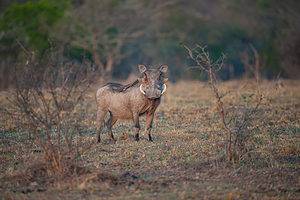Who doesn’t love the variety, fragrance, and visual appeal that roses offer? By far, roses of all varieties are the most often used flowering shrub for landscaping and gardening. There are more than 300 species of woody blooming perennials in the Rosa genus, and thousands of different rose varieties have been developed from these species.
While native roses may be found on almost every continent, the majority of landscape roses are multi-generational hybrid cultivars whose original species progenitors have long ago been lost. Modern rose varieties are nearly often sold by their own cultivar name rather than by the name of the species.
So, which rose is right for you? It can help to understand the various categories that roses fit into. In this guide, we’ll take a look at each and every type of rose by category, so you can make a more informed decision based on your landscaping or flowering-arranging needs.
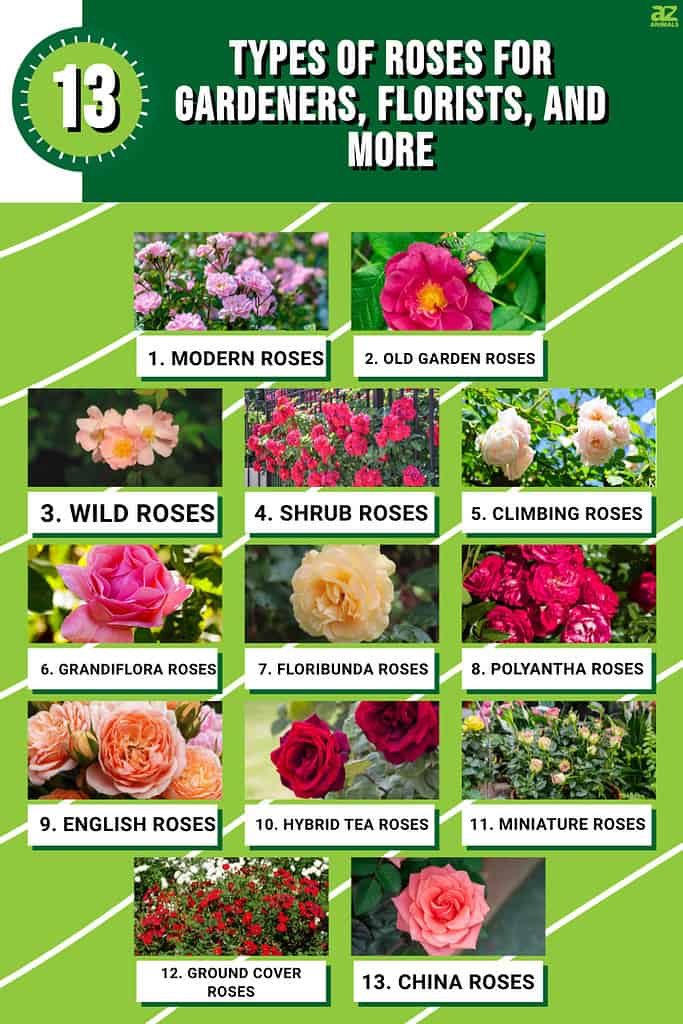
1. Modern Roses
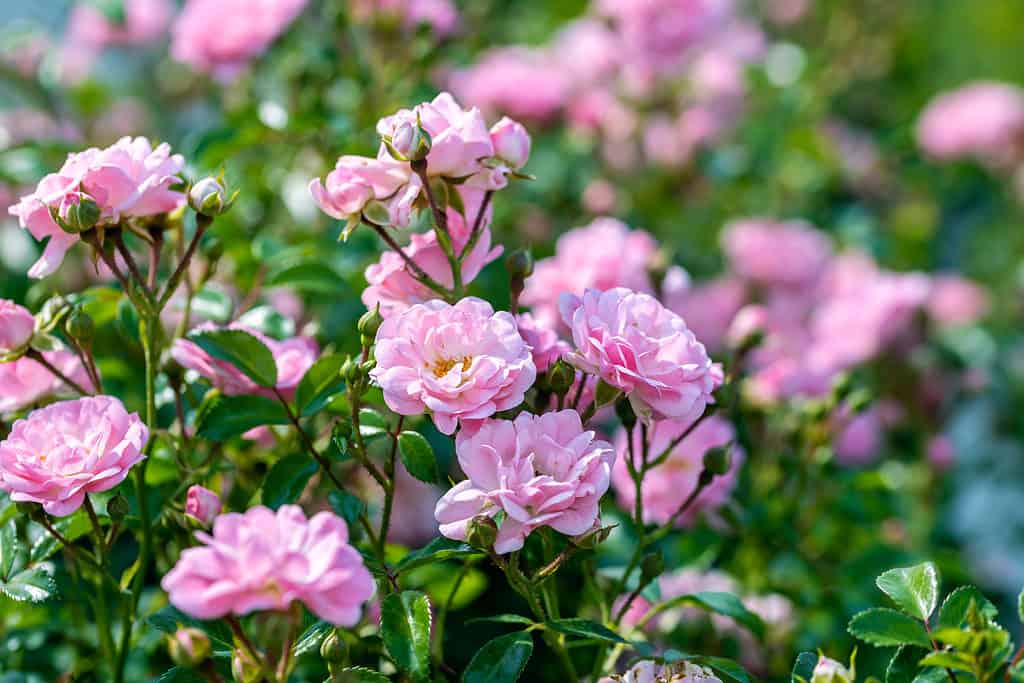
The Fairy Rose is a common variety of modern rose bred today and provide a continual bloom and a greater bloom size than old garden roses.
©Fabrizio Guarisco/Shutterstock.com
Modern garden roses are more likely to be what you will find as you peruse any rose collection, whether it be online or at a nursery. Old garden roses, a historical variety, were replaced by modern roses after 1867. There are certain differences between the two. Modern roses provide a continual bloom and a greater bloom size than old garden roses, which only bloom once a year. Modern roses are popular among florists and homes because they last longer in vases in water after being cut. These modern roses only have one drawback: they often lack a strong, intense aroma and aren’t as durable or disease-resistant as old garden roses.
2. Old Garden Roses
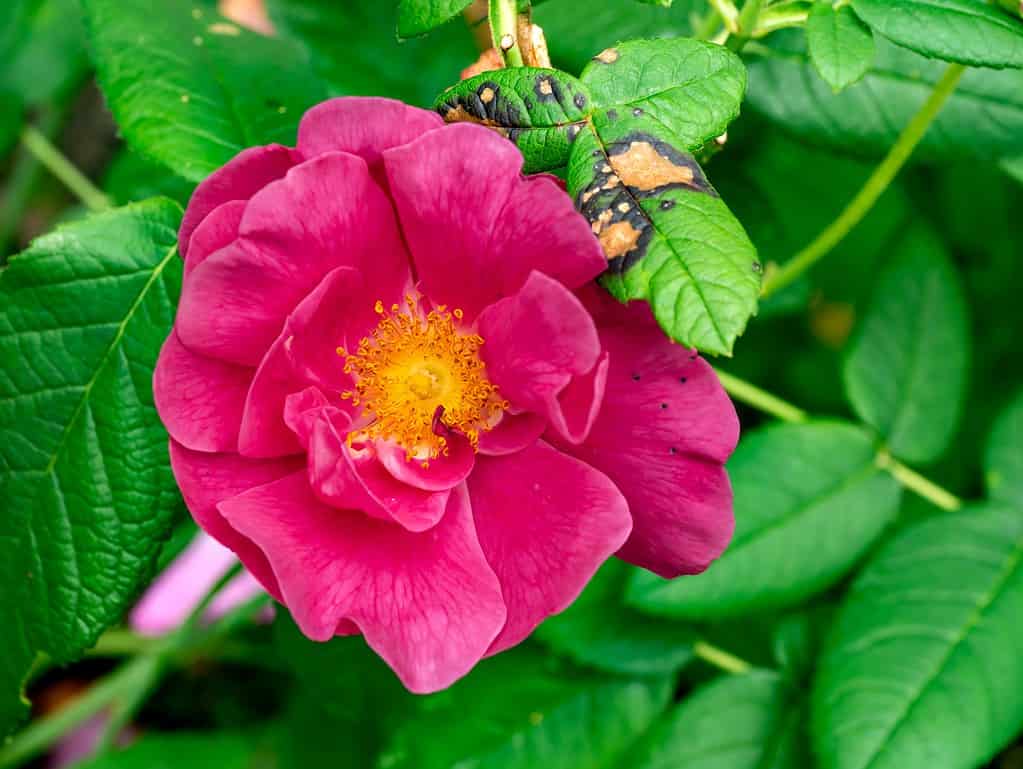
Rosa gallica, the Gallic rose, is a very old rose native to ancient Persia.
©TasfotoNL/Shutterstock.com
The old garden rose, often known as the antique or historic rose, has grown since before 1867. Unlike modern roses, which bloom continuously throughout the season, double-flower old roses only open once. They are also much more fragrant than modern roses. Old garden roses have the benefit of having developed over time to become more resilient and disease-resistant.
3. Wild Roses
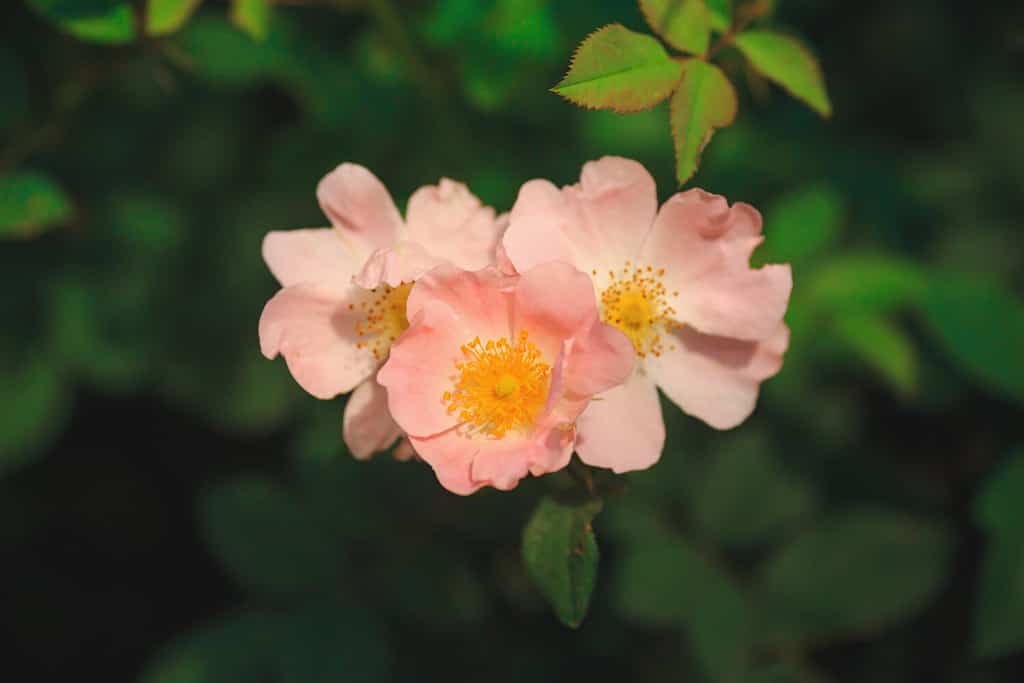
Typically, wild roses only produce one bloom, which has a five-petal blossom.
©Batechenkofff/Shutterstock.com
Wild roses, also known as species roses, are regarded as the wildflower form of roses and lack the history of hybridization and cross-breeding that other contemporary types have. Typically, wild roses only produce one bloom, which has a five-petal blossom. A wild rose may be identified most easily by its color, which is nearly always pink. In fact, finding a red or white wild rose is unusual. Unique colors like yellow, orange, or violet are extremely uncommon in wild roses.
4. Shrub Roses
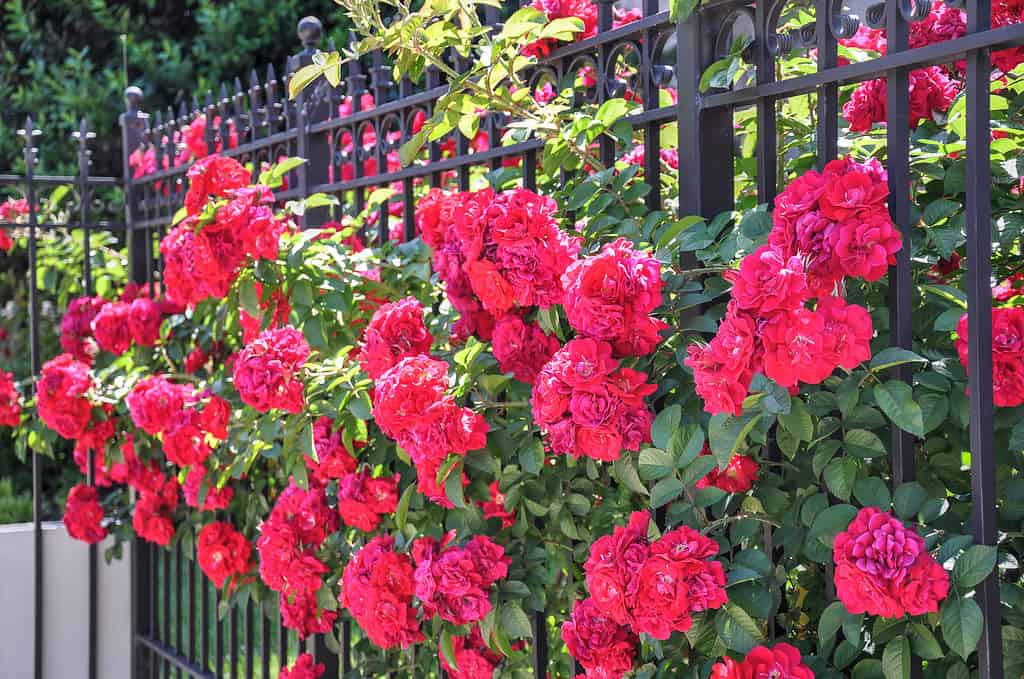
The Champlain rose is a type of shrub rose that is quite popular for planting around fences.
©Keri Delaney/Shutterstock.com
These roses are typically hardy and low-maintenance. The way the roses bloom on the shrub rose bush makes them easy to identify. Shrub roses produce clusters of blossoms rather than a single bloom per stem, and they may reach heights of 6 feet and a width of 15 feet. These roses typically spread out wide and far, anything from 5 to 15 feet in all directions.
Shrub roses are renowned for their cold tolerance and ability to endure harsh winters. Additionally, they produce abundant clusters of blossoms. The English rose is within the category of shrub roses, one of the several subcategories of shrub roses.
5. Climbing Roses
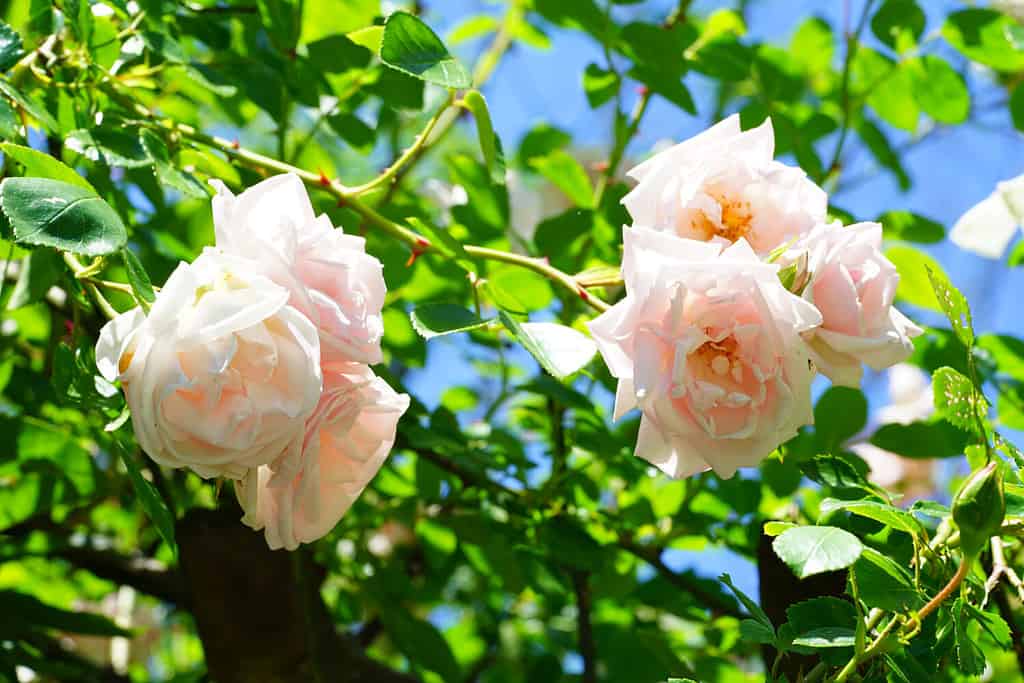
The ‘New Dawn’ Rose is considered one of the best climbing roses.
©EQRoy/Shutterstock.com
These roses are a type of modern rose. Climbing roses are not vines, despite what their name would suggest. A gardener may train their stiff canes to follow a trellis, fence, or other similar structure. Because of their 15-foot growth potential, these canes can grow to impressive heights along trellis walls, garden fences, and arbors and pergolas. These unique roses feature large, predictably reblooming roses. They have a tendency to produce more roses when grown in a horizontal fashion. Nearly all climbing roses are able to be repeat bloomers and produce enormous flowers with the right amount of care. One could come across either grandiflora or floribunda climbing roses.
6. Grandiflora Roses
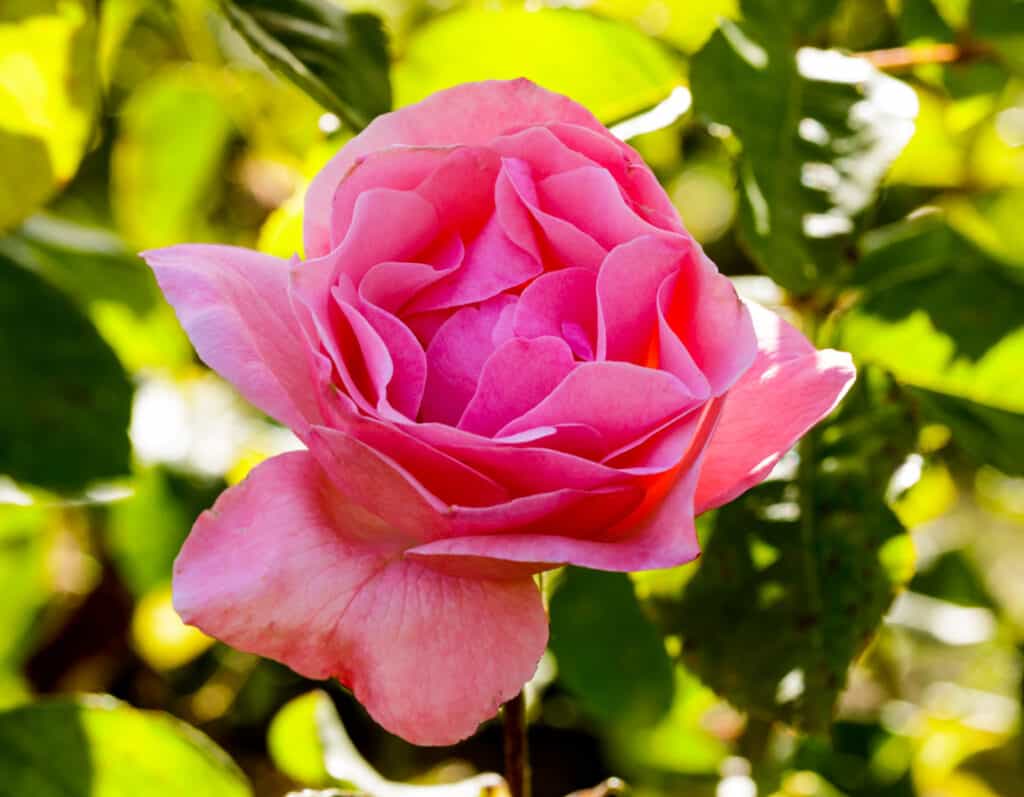
The Queen Elizabeth is an award-winning grandiflora rose known for its light scent and regal blossoms.
©iStock.com/yhelfman
These roses combine reblooming floribunda roses with the densely packed flowers of hybrid tea roses, albeit they are on stems that are still rather long. Shades of the grandiflora rose range from subtle pastels to deep, rich hues. They often have a sweet scent about them.
The grandiflora rose was developed about a century ago. Grandiflora roses have stunning spectacular flowers that occur in clusters like the hybrid tea rose and a consistent growth cycle like the floribunda rose, making them the ideal cross between the two types of roses. Additionally, each cluster has three to five flowers. Their bushes are often bigger and taller than hybrid tea roses. This type of rose is incredibly robust and vigorous even if it is not as well-known as its near relatives.
7. Floribunda Roses
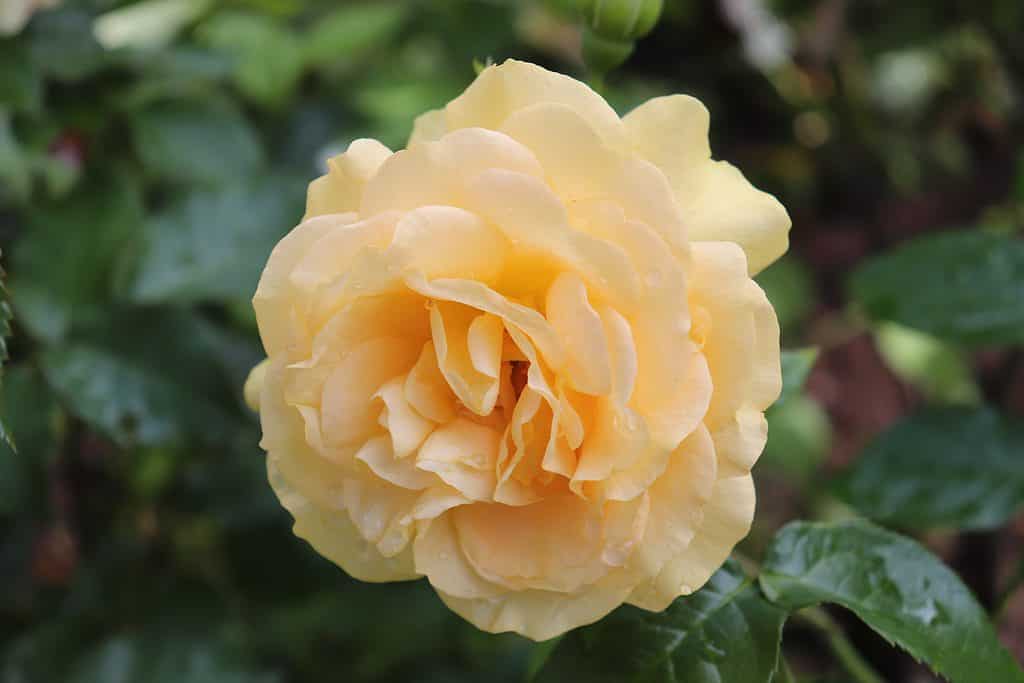
The yellow Julia Child rose is a type of floribunda rose.
©Galina Bolshakova 69/Shutterstock.com
Another popular rose class is floribunda roses. The floribunda rose has a big cluster of blooms that resembles the grandiflora rose. It will grow for far longer with a continuous bloom than the six to seven-week cycle of grandiflora or hybrid tea roses. Additionally, floribundas require very little maintenance and don’t need much human intervention to grow and flower.
These roses are a hybrid of polyantha roses and hybrid tea roses, making them perfect for planting in big beds and mixed borders in landscaping. Though some younger floribunda varieties are sweet-smelling, they normally don’t have a very strong or typically rose-like smell. This makes them great for gardeners who have allergies or scent sensitivities. Large clusters of these flowers are found in this category, providing vibrant color over a lengthy season.
8. Polyantha Roses
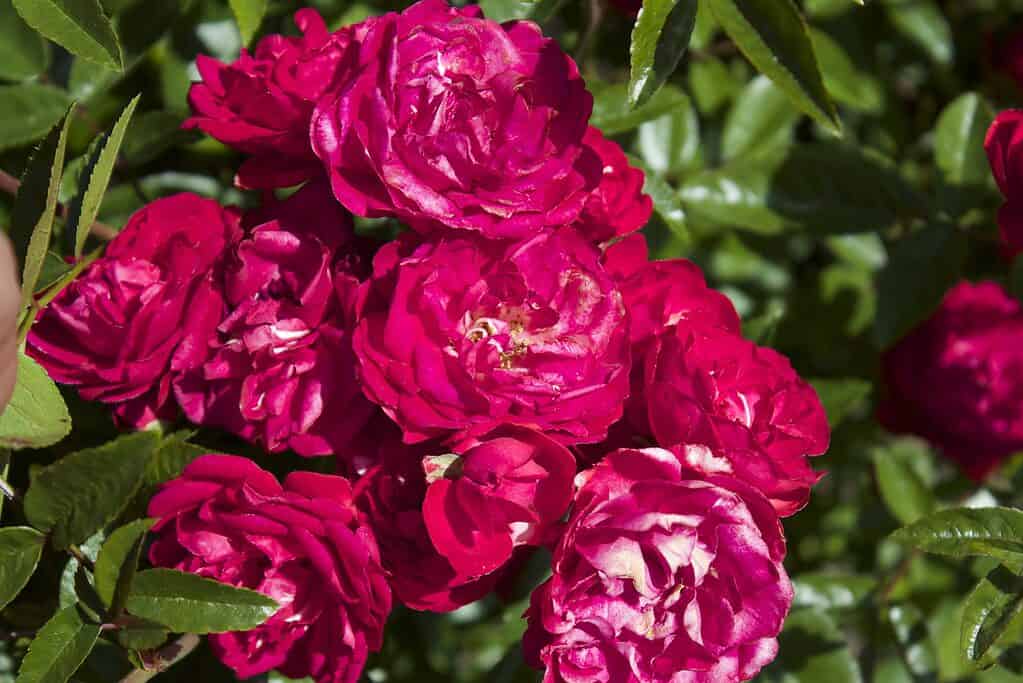
Polyantha rose ‘Muttertag’ is an excellent addition to pots and small gardens since they typically reach heights of up to 3 feet and blossom in enormous clusters of tiny 1-inch blooms.
©Patrick Nouhailler / Flickr – License
These little plants are excellent additions to pots and small gardens since they typically reach heights of up to 3 feet and blossom in enormous clusters of tiny 1-inch blooms. They are resilient, low-maintenance plants that are famed for being covered with blossoms from spring through autumn.
The lovely polyantha rose is shorter and has fewer flowers than floribunda roses. While certain backyard landscaping might not be a good fit, polyantha is ideal for edging and hedges. These rose bushes have a prodigious bloom that lasts from spring to fall, and it’s not uncommon to find them entirely covered in clusters of their little blooms.
Additionally, polyantha roses come in various shades and colors, including brilliant whites, charming baby pinks, and vibrant reds. The polyantha rose is a hardy rose, and because of its minimal maintenance requirements and disease resistance, it has remained a preferred choice for amateur gardeners and horticulturists. Grow them in a container or even a tiny garden space if you’re just starting out.
9. English Roses
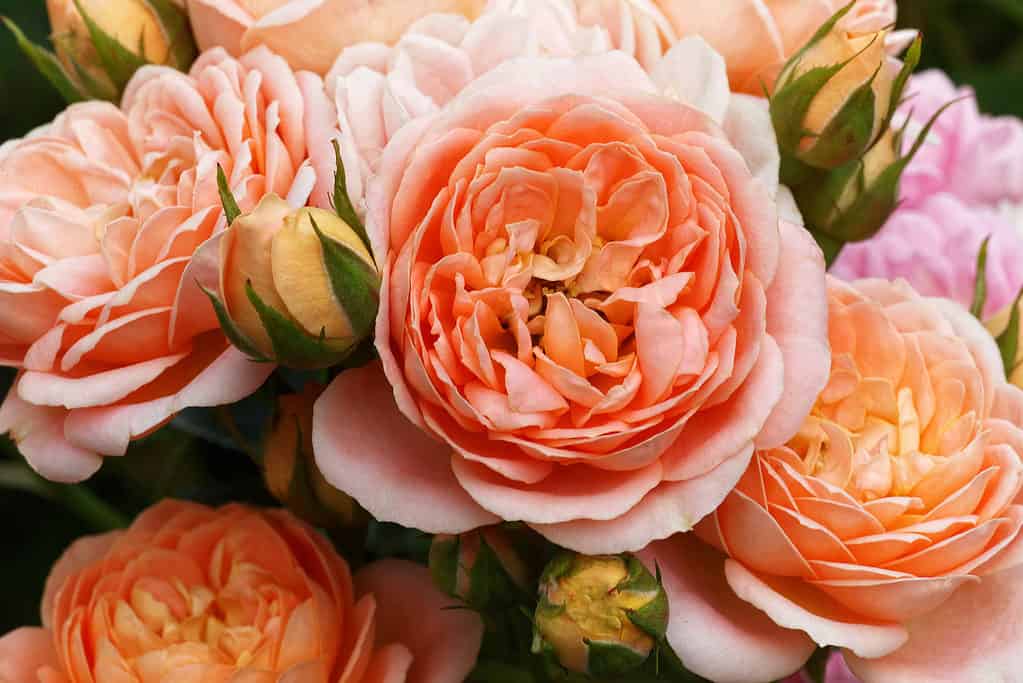
These roses, which come in various hues, have been meticulously developed for dependability, most notably by David Austin in England.
©MaCross-Photography/Shutterstock.com
English roses are another type of modern rose. This category of roses could be what you need if you want a strong, disease-resistant rose variety with a lovely classic aroma. These roses, which come in various hues, have been meticulously developed for dependability, most notably by David Austin in England. Since most are shrubby, they are suitable for nearly any garden setting, including formal settings, hedges, and containers.
These roses, which have hundreds of variants, are most frequently referred to as David Austin roses after the famed British rose producer. These rosette-shaped roses, which are very well-liked by both customers and retailers, have the scent of an old rose variety. They also will continuously flower and have a wide range of colors like modern roses do. English roses are for more seasoned gardeners and growers since they require more upkeep and care and are more sensitive to illnesses.
10. Hybrid Tea Roses
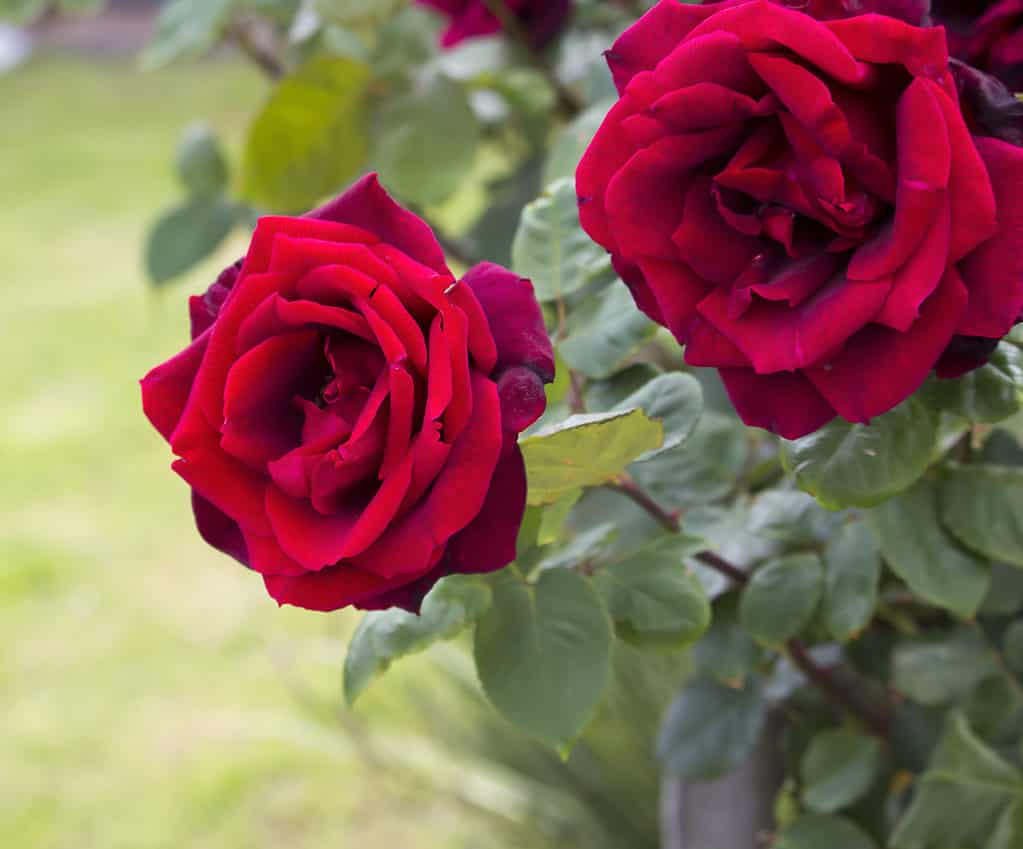
Beautiful velvety red fully blown hybrid tea roses produce a stunning display in any garden with its abundant, elaborate flowers.
©alybaba/Shutterstock.com
One of the most well-liked groups of roses among horticulturists is hybrid tea roses, and it’s easy to see why. The hybrid tea rose produces a stunning display in any garden with its abundant, elaborate flowers. With these roses, horticulturists have bred hundreds of hybrid types, and they don’t seem to have any interest in stopping anytime soon. New hybrids are constantly replacing outmoded hybrids, even today.
Large, high-centered buds with 30 to 50 petals each are seen on these garden roses, which are supported by long, straight, erect stems. They tend to rebloom and are well-liked as cut flowers. They may reach heights of 8 feet and widths of 3 feet. Although hybrid tea roses aren’t well-renowned for being disease resistant, they remain the standard rose in the florist business, despite many home gardeners avoiding this type.
11. Miniature Roses
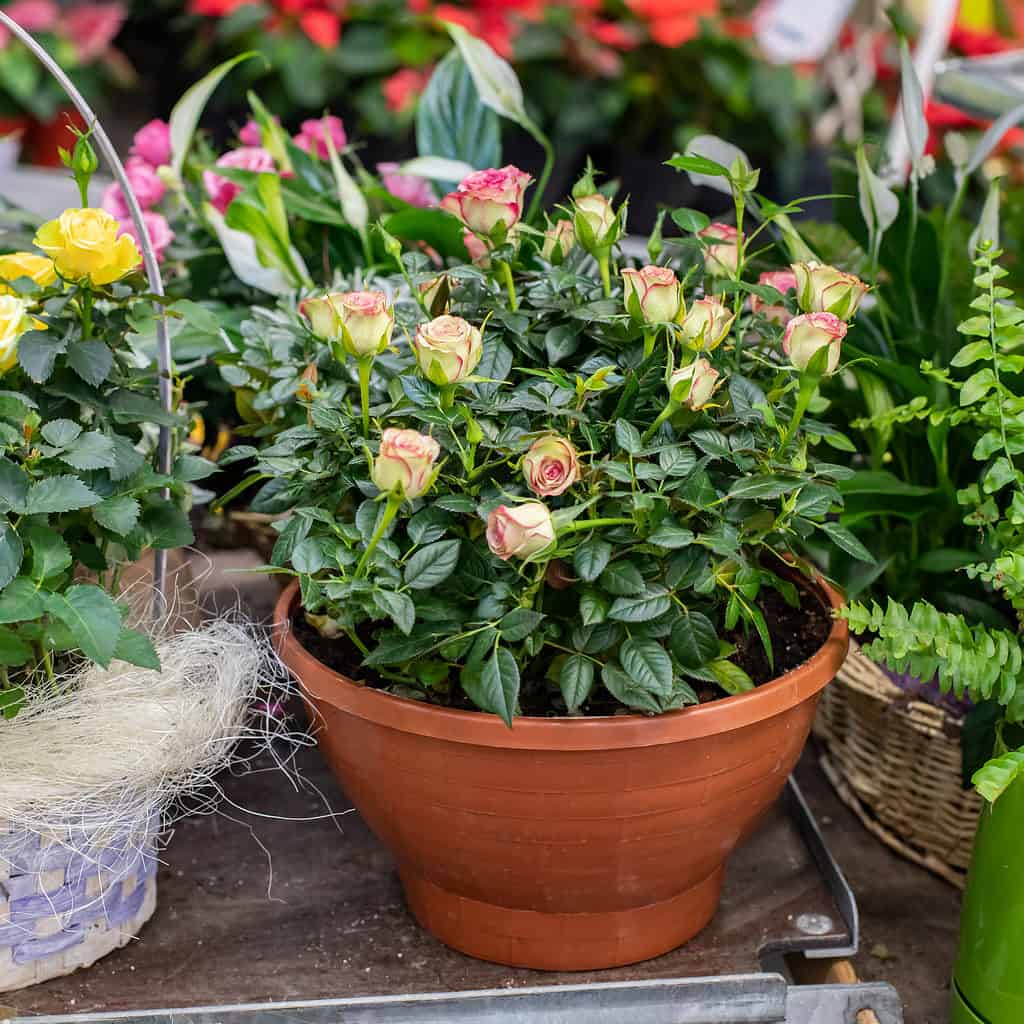
This resilient category of roses, which comes in many different varieties and colors, is bred to stay small in size.
©iStock.com/OlgaKorica
Miniature roses and miniflora roses are a type of hybrid tea, or even a grandiflora rose, that is normally a little shorter and more compact than your typical rose. A miniflora rose has intermediate-sized flowers more closely resembling a floribunda, while miniature roses can reach heights of up to 30 inches. In general, though, miniature and miniflora roses can be kept at a height of 10 inches with a bit of pruning and maintenance.
This resilient category of roses, which comes in many different varieties and colors, is bred to stay small in size. They maintain their tiny size quite easily, which makes them ideal for small gardens, pots, or border plantings at the front of rose gardens.
12. Ground Cover Roses
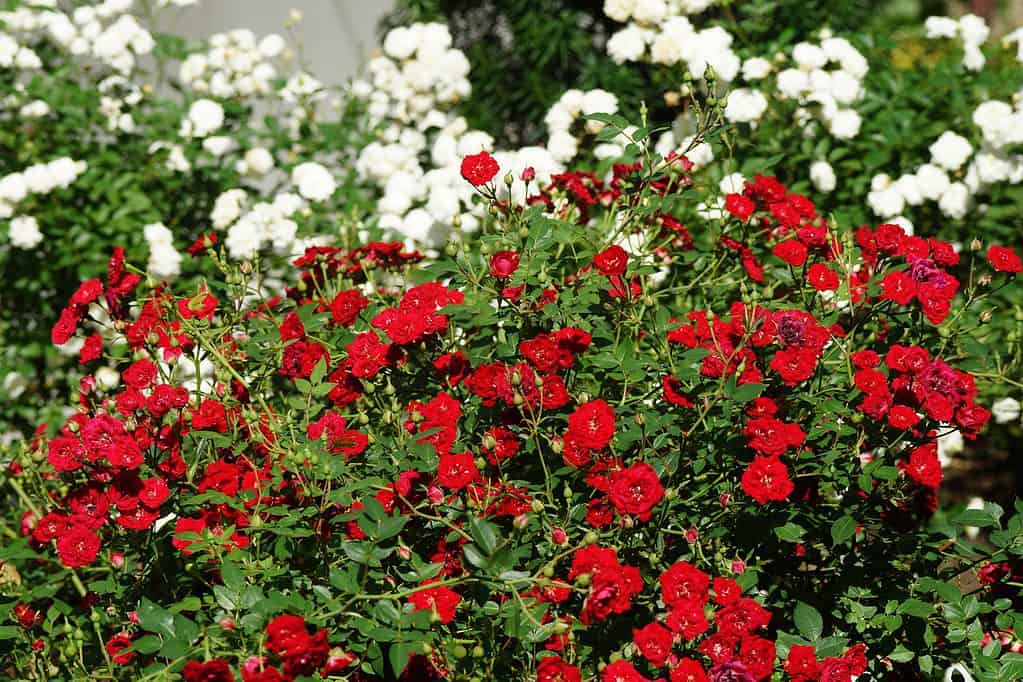
Ground cover roses are commonly referred to as landscape roses for their use in covering large areas in landscaping projects.
©Adam November/Shutterstock.com
Another modern rose category includes the ground cover rose. One of the more recent trends in roses is this low-growing category with several different cultivars. Ground cover roses are spreading shrubby roses. They are commonly referred to as landscape roses for their use in covering large areas in landscaping projects. These roses are available in single and double-bloom shapes and bloom effortlessly from spring till frost. They typically grow up to 3 feet tall and spread widely.
These roses were created to have the best of both worlds. They are a stunning garden addition with a bright color, elegant shape, and delightful smell. In addition, they do not need a ton of maintenance. Ground-cover roses are ideal as a space filler. This is due to the fact that they may spread out and only grow to a height of 3 feet. Ground-cover roses are often resistant to pests and diseases as well. These roses are among the greatest low-maintenance varieties, making them perfect for novice gardeners and rose producers.
13. China Roses
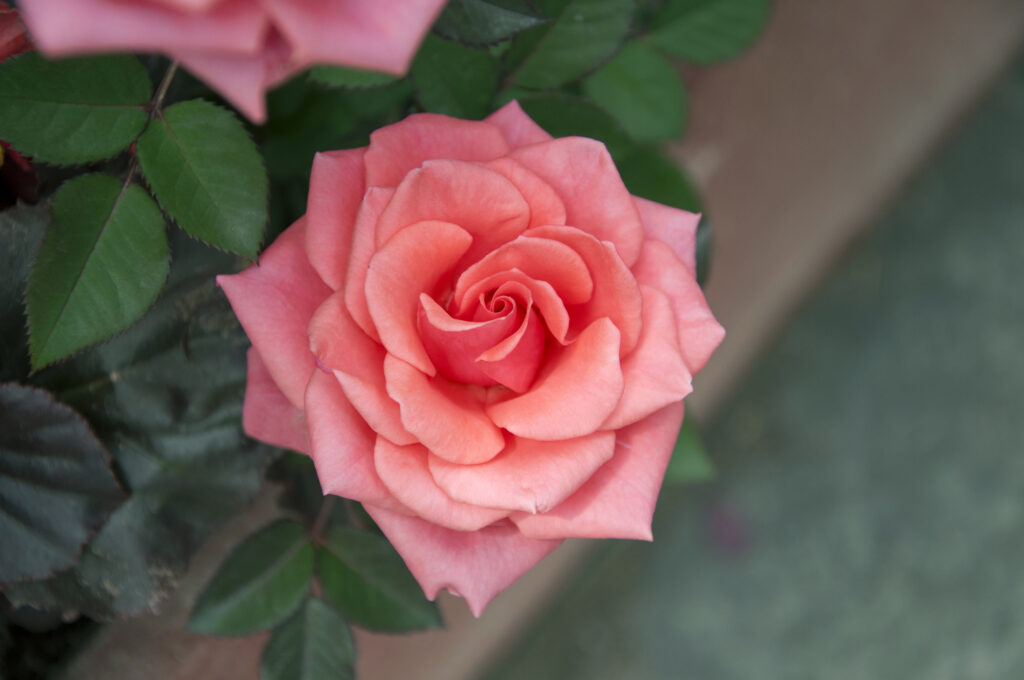
The peach-pink flower of Rosa chinensis, or the China rose, which have been grown for hundreds of years in East Asia.
©iStock.com/kit yu
These roses, which have been grown for hundreds of years in East Asia, usually have smaller flowers and less of a smell than other old garden roses. They are renowned for their propensity to darken in color with age as opposed to losing color (or becoming paler) like other rose blooms.
China roses were brought to the West in the late 18th century. This special rose has greatly benefited from hybridization. They boast compact, bushy blooms available in various hues, including vivid red, gentle pink, and joyful yellow. This hybrid rose’s disease tolerance and capacity for several blooms from summer to late fall are among its biggest benefits.
Summary of 13 Types of Roses for Gardeners, Florists, and More
There are so many different types of roses out there when it comes to the general category alone. In each of the categories we explored in this guide, there are dozens, if not hundreds, of different cultivars or varieties. If you need a very specific type of rose, chances are you’ll be able to find it with just a little bit of research!
Here’s a recap of the 13 rose categories we took a look at.
| Number | Rose Category | Known For |
|---|---|---|
| 1 | Modern Roses | Providing a continual bloom and a greater bloom size than old garden roses |
| 2 | Old Garden Roses | Being more fragrant and disease-resistant than modern roses |
| 3 | Wild Roses | Regarded as the wildflower form of roses |
| 4 | Shrub Roses | Renowned for their cold tolerance and ability to endure harsh winters |
| 5 | Climbing Roses | Due to 15-foot growth potential, can grow to impressive heights along trellis walls and fences |
| 6 | Grandiflora Roses | A combination of reblooming floribunda roses and densely packed hybrid tea roses |
| 7 | Floribunda Roses | Great for gardeners with allergies or scent sensitivities as they don’t have a very strong or typically rose-like smell |
| 8 | Polyantha Roses | Good choice for amateur gardeners due to minimal maintenance requirements and disease resistance |
| 9 | English Roses | Disease-resistant varieties with a lovely classic aroma meticulously developed for dependability |
| 10 | Hybrid Tea Roses | Standard rose in the florist business; horticulturists have bred hundreds of hybrids |
| 11 | Miniature Roses | Ideal for small gardens, pots, or border plantings as these are bred to stay small in size |
| 12 | Ground Cover Roses | Low-maintenance varieties referred to as landscape roses for use in covering large areas |
| 13 | China Roses | Renowned for their propensity to darken in color with age |
The photo featured at the top of this post is © iStock.com/Vivian Song
Sources
- NCSU Staff, Available here: https://plants.ces.ncsu.edu/plants/rosa/
- Sheryl Geerts, Available here: https://www.bhg.com/gardening/flowers/roses/ultimate-rose-care-guide/
- Jackson & Perkins Staff, Available here: https://www.jacksonandperkins.com/ultimate-guide-rose-types/a/types-of-roses/
FAQs (Frequently Asked Questions)
How many types of roses are there?
There are over 150 species in the Rosa genus, with thousands of varieties and hybrids of those species.
What are the main categories of roses?
The main categories of roses include old roses, wild roses, and modern roses.
When were roses first cultivated?
Roses were first cultivated around 5,000 years ago. Fossil evidence has shown that wild roses have existed since the prehistoric era.
Thank you for reading! Have some feedback for us? Contact the AZ Animals editorial team.



